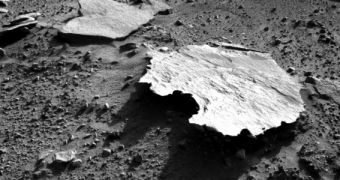Twitter user @CoUdErMaNn recently caused an image collected by the NASA Mars Science Laboratory (MSL) rover Curiosity to go viral, after he pointed out that one of the rocks in the photo resembled Australia. The view was captured at Kimberley, the new location that the robot reached and where it is scheduled to spend the next few weeks conducting scientific studies.
Coincidentally, the outcrop Curiosity is getting ready to study in detail was named after a region in Western Australia. The rock it recently imaged lies right in front of the rover and resembles the continental island in significant detail. The formation appears to have formed through a series of erosion processes, meaning that geologists will most likely fret over it for a while, Space reports.
Psychologists say that recognizing the shape of Australia in this Martian rock is a clear example of how a phenomenon called pareodolia works. The term, which is Greek for instead (para) and form or shape (the noun eidōlon), refers to a psychological phenomenon where vague or random stimuli perceived by humans catch on new meaning.
Examples of this include recognizing hidden messages when playing songs in reverse, seeing the famous Man in the Moon, identifying the faces of people and animals in clouds, or seeing holy or famous people on toasted bread. This ability to see patterns in random data is essential for the human brain, helping it to save some energy as it makes sense of the world around us.

 14 DAY TRIAL //
14 DAY TRIAL //